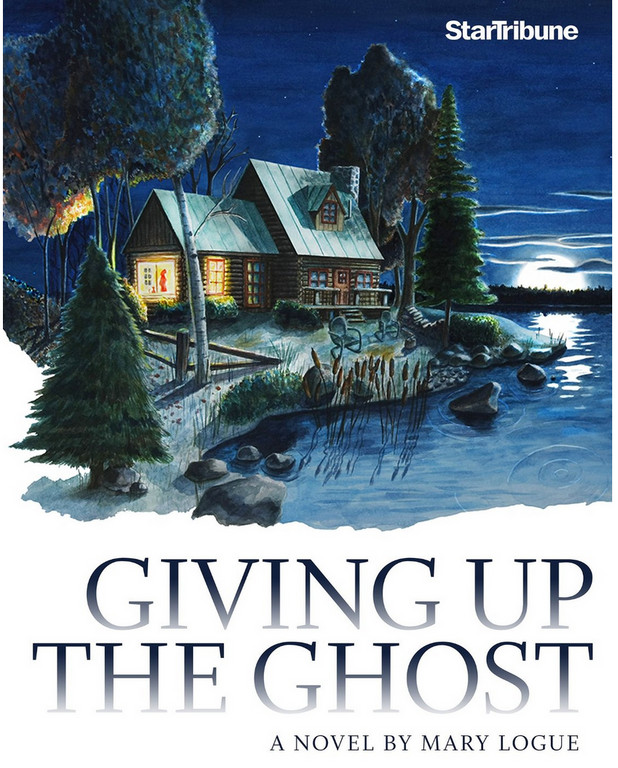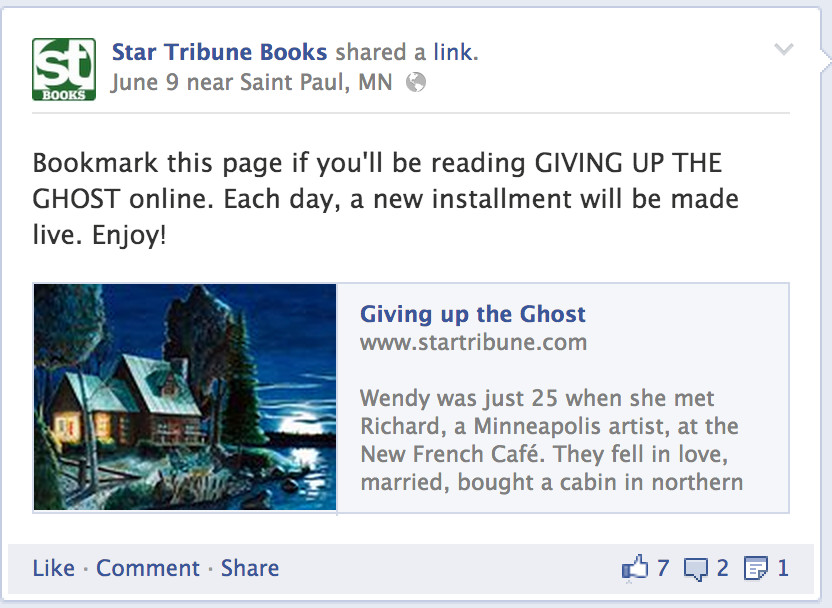How Minneapolis Star Tribune serialized local novelist, published third e-book
Sense of place, engaged author are keys to successful "Giving Up The Ghost"
Company: Star Tribune Media Company LLC
Market: Minnesota and Upper Midwest
Media: The Star Tribune, the 12th largest U.S. daily newspaper
Audience: 1.3 million adults weekly for the newspaper and 7 million unique online visitors monthly
Key executives: Cory Powell, managing editor of new products and innovation; Kate Parry, assistant managing editor for features and special projects; Laurie Hertzel, books editor; and Jamie Hutt, digital design director.
Challenge: The Star Tribune, a Minnesota-based media, had expanded its digital reach with original ebooks, available for purchase through Amazon, Barnes & Noble, and Apple's iTunes store. In 2012, the Star Tribune published reporter Curt Brown's true life history about the U.S./Dakota War, In the Footsteps of Little Crow, and bundled recipes from their annual cookie contest into one ebook, The Cookie Book: 10 Years of Winning Recipes from our Holiday Baking Contest. They were ready to try a serialized work of fiction.
Cory Powell says, “Serialized fiction was a staple for newspapers a century ago—we were curious to see if we could have success bringing back an old form. Additionally, summer felt like the right time to roll out a good tale.”
Strategy:
1. Author Selection Criteria
The team set a specific list of content qualities they were seeking, including a book without too much sex or gore that would appeal to their base of readers in particular and women in general. They also needed a book that would translate well into short serialized segments. In the Footsteps of Little Crow had been popular with teachers and ordered into area schools as it concerned Minnesota history. Similarly, it was important to the team that the winning title have a strong sense of place that would resonate with Minnesota readers.
2. Reaching out to the book community
While the first books tapped the newspapers own material and reporters, the serialized novel required them to look outside their own staff.
Books editor Laurie Hertzel reached out to literary agents and bookstore owners in the local publishing industry in search of a high-quality fiction writer based in Minnesota, eventually coming up with five recommended manuscripts to choose from.
The group eventually selected novelist Mary Logue, whose audience trends female, and because her novel, Giving Up the Ghost, is locally based.
One of the most critical elements to success was that Logue, a veteran author with more than 25 titles to her name, was willing to be flexible and adapt to new media.
In her mid-serialization interview, Logue told the Star Tribune that she had once wanted to be a journalist and had written book and music reviews for their paper in the past. She was intrigued at the thought of book publication partnering with newspapers to keep both in the hands of readers.
3. Product Development
Creating the serialized ebook did not require hiring outside consultants and the Star Tribune was able to use all in-house staff and create the book using simple tools they already worked with, from Adobe Design. The publishing team was made up of copy editors, primary editors, web designers, an ebook designer, an artist who painted the cover design, and a graphic designer who turned the painting into a digital cover.
“The design tools for an ebook are the same that designers use for other projects—it's merely the output that's different," Powell explains. "Our designers had to learn some about cascading stylesheets, but they were able to tap into the knowledge of our web design staff for that. Truthfully, there's not nearly as much design involved in creating an ebook as there is in many of our other projects.”
The team then uploaded the electronic book to the Kindle Direct Publishing Dashboard, Apple iTunes Partner Program, and Barnes and Noble’s Vendor of Record initiative. All of these now offer self-publishing options that are straight-forward and easy to navigate. iTunes reserves the right to approve the project. All require the text to be submitted in EPUB format.
4. Pricing and contractual details
Logue's contract lined up to industry standards, Powell says. Electronic novels typically garner more of a royalty percentage than print books because of the lower overhead costs.
The ebook sells for $3.99 and the overall profit percentage is 70% from Apple and Amazon.
Although contract terms with the author are confidential, Powell says that Logue was offered an advance and has a contract that runs several years.
The cost to produce the book was minimal as salaried staff time was used to break the completed novel into sections.
5. Timing and placement
Summer was deemed the perfect time to experiment due to the slower news cycle. The team decided the serialization would need to keep readers engaged for 50 consecutive installments, running June 9-July 28, 2013. Placement was also a key factor. The team wanted to avoid placing the novel on the front page of the paper and then asking people to flip back to the feature section. Instead, they started with the story taking up the entire first page of the Variety section on the first day and then playing with different placements, such as a bar down the side or across the bottom of the page. Those who missed installments could read them online or order the electronic version of the novel.
6. Promotions
To publicize the project, the team issued a press release and arranged interviews for key staff members in-house and with such media as Publisher's Weekly prior to publication. Poynter also did a follow-up interview during the serialization's run.
The readership of the Star Tribune was the primary audience, however, offering a built-in base of readers who would follow the story throughout its entirety. The team promoted the book with house ads, as well as announcements and news on their Facebook page and Twitter feed, and on the cover of their Variety section before launching in that section. Here's an example of a Facebook post:

Additionally, the Star Tribune's editor Nancy Barnes wrote about her decision to launch the novel and Mary Logue participated in a live chat with the editor and some 600 fans. The paper printed a Q&A with Logue prepublication and again when she was midway through the serialization. The book was also advertised both in print and online.
Results:
• Priced at $2.99, In the Footsteps of Little Crow had reached No. 13 on the New York Times eBook Bestseller List and even briefly rested at No. 8 on Amazon. It is too soon to know final results for Giving up the Ghost, priced at $3.99, but Collin says reviews on Amazon have been excellent, averaging 4.5 out of 5 stars.
• Powell notes that the Star Tribune has not yet conducted its project review for Logue’s serialized novel, so it is too soon to tell what they might do differently next time. He adds that the team was a bit surprised by “the time and effort required to edit a manuscript into serial form." This is a challenge that other papers producing serialized content have faced as well (the New York Times and the Boston Globe are two examples).
• Parry and Hertzel stated that they receive regular requests for another serial, but the paper is still deciding whether they will run more books in this format.
• The format of an electronic book is quite different than the short, matter-of-fact stories newspapers are accustomed to producing. Even with chapters in place, it can be difficult to know where to split a story and how to lay it out in the paper so it flows correctly. Logue did not write the book during its serialization but rather, gave the team a completed manuscript in advance. This is recommended.
• Media companies wanting to reproduce this experiment may want to try a mix of using in-house editors and designers combined with an ebook publishing company like Byliner, which is used by the Times, New York Magazine, and Esquire.
Resources:
Adobe InDesign (already owned by the production department); Adobe PhotoShop and Adobe Illustrator (already owned and used by the graphic design team).









